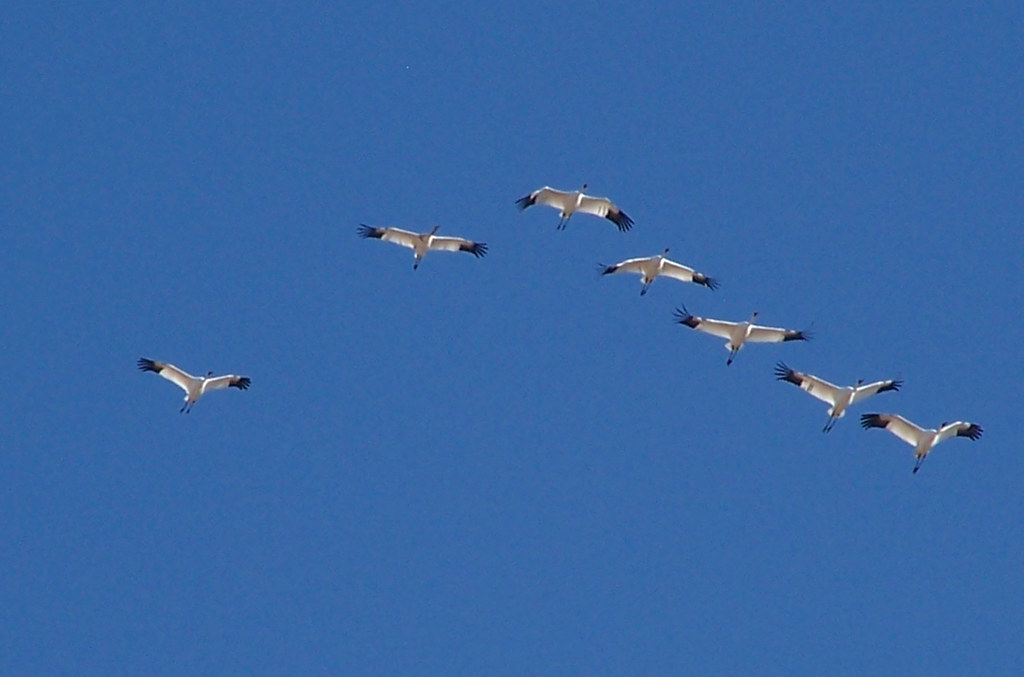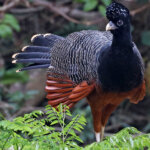The Fascinating Whooping Crane!
The whooping crane (Grus americana) the tallest North American bird is an endangered crane species named for its whooping sound. Along with the sandhill crane, it is one of only two crane species found in North America. The whooping crane's lifespan is 20 to 30 years in the wild. After reaching sexual maturity at 4 to 6 years they mate for life and produce one chick per year.
The whooping crane's diet consists mostly of blue crabs, crayfish, frogs, and reptiles. To find food they use their long necks and bills to probe in the mud. In the winter months when food is scarce they will also eat plants.
Whooping crane population
Whooping cranes are one of the rarest birds in North America. In the early 1800s, there were an estimated 10,000 whooping cranes. By the 1940s that number had dwindled to just 21 birds. Today there are about 600 whooping cranes in the wild. The majority of the population nests in Wood Buffalo National Park in Canada and winters in Aransas National Wildlife Refuge in Texas. In addition to these two main populations, there is a small non-migratory flock in central Florida and another small flock that migrates between Wisconsin and Louisiana.
Whooping crane habitat
The whooping crane is one of the most endangered bird species in North America. In 1941 there were only 21 wild whooping cranes remaining. Today thanks to conservation efforts there are about 600 birds in the wild and about 200 in captive breeding programs. The primary habitats of whooping cranes are marshes and wet meadows. They nest in trees or shrubs near water. Whooping cranes spend their winters in the Gulf Coast region of the United States.
Whooping crane migration
Whooping cranes are one of the world's most endangered species. Every year they migrate from their breeding grounds in Canada to their wintering grounds in the southern United States. The journey is long and dangerous and many whooping cranes never make it to their destination.
There are several organizations working to protect whooping cranes and help them on their migration journey. One such organization is the Whooping Crane Eastern Partnership which operates a crane migration corridor in the eastern United States. The corridor provides a safe passage for whooping cranes as they travel between their breeding and wintering grounds.
What is the survival rate for whooping cranes raised by sandhill cranes?
The survival rate for whooping cranes raised by sandhill cranes is about 50%. The main reason for this is that sandhill cranes are not used to raising whooping cranes and often accidentally kill them.
What is the significance of the whooping crane in Seminole Indians?
The Seminole Indians of Florida believe that the whooping crane is a sacred bird. The crane is the only natural predator of the alligator and the Seminole believe that the crane was sent by the creator to help them in their fight against the alligator. The Seminole also believes that the whooping crane is a symbol of strength and courage and that it is a messenger between the spirit world and the physical world.
What is the whooping crane status after the freezing temperatures in Port Aransas in February 2021?
As of February 16.2021, the Aransas National Wildlife Refuge has reported that 22 whooping cranes have died as a result of the deep freeze that swept through Texas. This is a devastating blow to the population of wild whooping cranes as there are only about 800 of them in existence.
The whooping crane is an endangered species and the loss of even a few individuals can have a significant impact on the long-term survival of the species. The Aransas NWR is currently working to rescue any remaining cranes that may be in danger and to provide care for the cranes that have already been affected by the cold weather.
How do whooping cranes know where to land?
Whooping cranes are guided on their migration routes by a number of cues including the position of the sun stars and magnetic fields. They likely also use landmarks and other visual cues. It is believed that whooping cranes learn the migration route from their parents who teach them the way during their first migration. By following these cues whooping cranes are able to travel hundreds or even thousands of miles to their breeding grounds.
How are Burmese pythons and whooping cranes similar?
Burmese pythons and whooping cranes are both large long-necked animals. Burmese pythons can grow to be over 20 feet long while whooping cranes are about 5 feet tall. Both animals are native to Asia and both are considered to be endangered species. Whooping cranes are hunted for their feathers while Burmese pythons are hunted for their skin.










